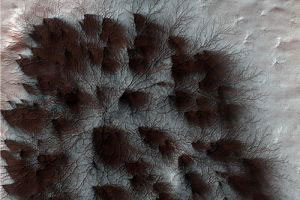 NASA/Mars Reconnaissance Orbiter; Fans of dark dust on Mars'
NASA/Mars Reconnaissance Orbiter; Fans of dark dust on Mars'
southern ice cap, apparently blasted from beneath the ice
by thawing carbon dioxide."
It's spring again, that time of year when my thoughts return to…blasts of carbon dioxide gas jetting up from beneath the frigid layer of dry ice below, carrying rusty red dust in plumes that jet toward the pale skies....
At least, that's what happens at the polar ice cap on the planet Mars. I'd sure love to be there to see it, even if there are no flowers in bloom. Still, there seems to be plenty of "blossoming" going on....
NASA's Mars Reconnaissance Orbiter—the spacecraft with that high powered camera that could spot a beach ball on Mars' surface—has captured images of the aftermath of some of Mars' springtime polar action. Appearing as dark fan-shaped bursts strewn across the thinning springtime polar ice, these features are explained as plumes of Martian dust that have settled after being blasted into the air by releases of gas pressure from under the surface of the ice.
To describe what's going on, let me paint a picture of the Martian polar region as it emerges from the deep freeze of winter into spring.
Mars' year is almost twice as long as Earth's—and so too are its seasons. Winter at the southern pole of Mars lasts almost six months. In that time, the normally freezing temperatures on the Red Planet plummet to as low as -225 degrees Fahrenheit at the pole. During this time, Mars' permanent water ice cap acquires a layer of frozen carbon dioxide (dry ice) on top, formed from carbon dioxide freezing directly out of the atmosphere.
